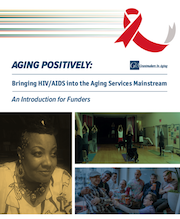Aging Positively: Bringing HIV/AIDS into the Aging Services Mainstream

For decades, aging and HIV/AIDS and their medical, governmental, community, and philanthropic structures and services were worlds apart. This made sense at first, when the majority of the first generation of people affected by HIV were young gay men, many of whom got their care in HIV-specific or infectious disease settings. The odds of living a long life with HIV/AIDS were small, and even survivors did not seek traditional aging services.
Those circumstances have now changed. Thanks to advances in treatment, the ability to live for decades with HIV has become a remarkable success story. Add to this the reality of older people who are acquiring the infection in their 50s or 60s, and HIV/AIDS must now be included as an aging issue. Of the 1.1 million people in the United States who are living with HIV/AIDS, half are 50 or older (50+). By 2030, it is anticipated that three out of four people who are living with HIV will be 50+.
The whole-person outlook and community-based approach of aging services has the potential to bring comfort to this resilient but overlooked group of people. This report will raise the voices and examine the needs of older people living with HIV, while exploring opportunities for philanthropies to create meaningful impact in public and personal health and wellbeing.
